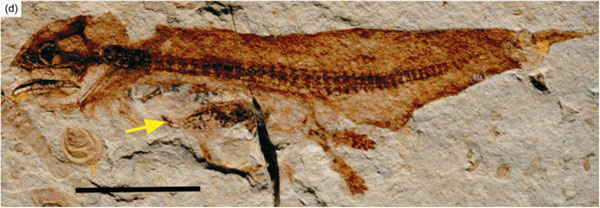Salamanders are slick-skinned amphibians whose diets shift as they mature. Some live their entire lives in water, and others spend their adult lives on land. Those inhabiting water eat plankton when young and then various insects and other small arthropods called "clam shrimp" when older.
Researchers know this from examining the stomach contents of modern salamanders. But if today's salamanders evolved from some amphibian-like ancestor, shouldn't that ancestor look significantly different from its present-day descendants? And since it could only eat those creatures that lived at that time—creatures that had not yet evolved into today's life forms—wouldn't it have had a different diet?
That doesn't seem to be the case with two newly described fossil salamanders from China.
These specimens came from a deposit near Daohugou village, which is famous for its remarkably preserved fossils. The fossils show the salamanders' bones, skin outlines, and stomach contents. Researchers believe the salamanders are perhaps 150 million years old, but they look almost the same as living salamanders, and they apparently ate the same food.

Publishing in the Chinese Science Bulletin, three paleontologists described the fossils as being "well-preserved as articulated skeletons, even retaining soft tissue impressions." The fossils showed more than just impressions in mudstone, however. The study authors wrote, "It is obvious that more organic residue (shown by the darker color) is preserved on the surfaces of the carapaces in the gut of the salamander than on those outside, providing further evidence for their being the food of the predator."1
They did not test whether the dark fossil material was original and not mineralized soft tissue, but other fossils from the same area appear to have original organics. For example, researchers described lizard skin impressions that may preserve original skin in dark patches.2 Also, two different Daohugou spider fossils have dark-colored exoskeleton outlines,3,4 and one Daohugou specimen contains pterodactyl skin fibers.5 If direct tests verify biological materials such as protein and chitin, as other similar fossil troves have shown,6 they wouldn't support the millions-of-years age assignment because such tissues only last hundreds of thousands of years at most.
The fact that these fossil salamanders look much the same as their living counterparts also fails to show millions of years' worth of evolutionary modifications. The Chinese study authors wrote, as an example, "The Jurassic cryptobrachid [sic] Chunerpeton has a flat skull, as does its living relative the Chinese giant salamander, Andrias davidianus, which is benthic [bottom-dwelling]."1
So, if salamander bodies have not really evolved, have their diets? Apparently not, according to the authors: "It is not surprising to discover that a Jurassic salamander ate conchostracans [clam shrimp]."1 Living salamanders also eat these.
Even the tiny fossil insects preserved in the fossil salamander stomachs looked the same as living insects called corixids, also known in the United States as "water boatmen." The authors wrote, "Extant [living] corixids mostly inhabit ponds and slow-moving streams where they forage on the bottom ooze; this was probably also true of the corixids at Daohugou."1
These salamander fossils appear in the fossil record fully formed, as though created—complete with the same diet and habitat as their living counterparts. In the same way, two spiders from the Daohugou beds look just like their living counterparts and show no evolution.3,4
A researcher compared one of them to its still-living version, telling Wired Science, "Looking at modern ones, you think, well, it's just a dead ringer."7
References
- Dong, L. P, D. Y. Huang and Y. Wang. 2012. Two Jurassic salamanders with stomach contents from Inner Mongolia, China. Chinese Science Bulletin. 57 (1): 72-76.
- Evans, S. E. and Y. Wang. 2007. A juvenile lizard specimen with well-preserved skin impressions from the Upper Jurassic/Lower Cretaceous of Daohugou, Inner Mongolia, China. Naturwissenschaften. 94 (6): 431-439.
- Thomas, B. Jurassic Spider: What's in a Name? ICR News. Posted on icr.org April 28, 2011, accessed February 7, 2012.
- Thomas, B. Spectacular Spider Is a Long-Living Fossil. ICR News. Posted on icr.org February 24, 2010, accessed February 7, 2012.
- "…the holotype of J. ningchengensis [pterodactyl] clearly shows fibres that are best interpreted as integumental covering." Kellner, A. W. A. et al. 2010. The soft tissue of Jeholopterus (Pterosauria, Anurognathidae, Batrachognathinae) and the structure of the pterosaur wing membrane. Proceedings of the Royal Society B. 277 (1679): 321-329.
- Published Reports of Original Soft Tissue Fossils. Institute for Creation Research. Posted on icr.org July 21, 2011, accessed February 7, 2012.
- Ghose, T. Stunningly Preserved 165-Million-Year-Old Spider Fossil Found. Wired Science. Posted on wired.com February 9, 2010, accessed February 9, 2012.
Image credit: Copyright © 2011 Dong LiPing, Huang DiYing and Wang Yuan. Adapted for use in accordance with federal copyright (fair use doctrine) law. Usage by ICR does not imply endorsement of copyright holders.
* Mr. Thomas is Science Writer at the Institute for Creation Research.
Article posted on March 12, 2012.



